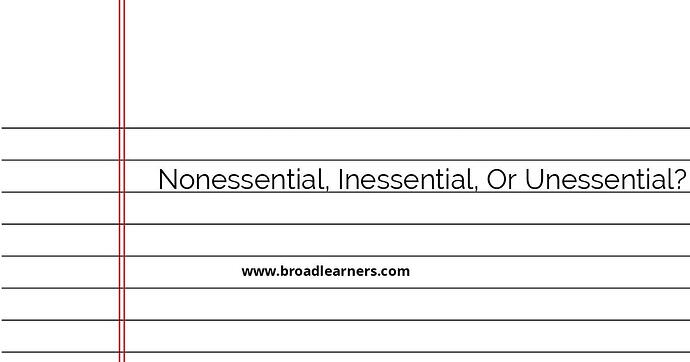Discerning between the terms 'nonessential,' 'inessential,' and 'unessential' can be a bit perplexing, but it's crucial for ensuring clarity in communication. While these words are often used interchangeably, they have subtle differences that can influence their appropriateness depending on the context. In this article, we will explore each term in detail and provide illustrative examples to enhance understanding.
- Nonessential
-
The term 'nonessential' is commonly used to describe something that is not necessary or not required for the fundamental operation or purpose of a particular activity or entity. It tends to imply an objective assessment, where an item or element can be clearly categorized as surplus to the core needs.
Example using 'Nonessential':
The company decided to cut nonessential travel to save on costs.
In this example, 'nonessential travel' refers to trips that are not critical to the business operations and could be eliminated without impacting the core responsibilities or performance.
- Inessential
-
Similar to 'nonessential,' 'inessential' also refers to elements that are not vital. However, it might carry a slightly more informal tone and can imply that the items are not valued or that they hold lesser significance.
Example using 'Inessential':
The decorator suggested removing some inessential items to create a minimalist look.
Here, 'inessential items' are those that do not contribute meaningfully to the overall aesthetic and could be eliminated to achieve the desired minimalist effect.
- Unessential
-
The expression 'unessential' is another alternative to 'inessential' and 'nonessential,' sharing similar meanings. It often indicates superfluousness and is sometimes considered less formal. However, in many contexts, it can be used synonymously with the other two terms.
Example using 'Unessential':
The emergency kit should not contain unessential items that take up space needed for critical supplies.
In this context, 'unessential items' are those that do not add value to the purpose of the kit and can be removed to make room for more important items.
In summary, while 'nonessential,' 'inessential,' and 'unessential' are largely interchangeable, choosing between them can depend on the formality of the context and subtle differences in tone. 'Nonessential' is more common in formal contexts, 'inessential' tends to be used in a slightly informal tone, and 'unessential' can fit informal contexts but can also efficiently communicate the concept of superfluousness across varying settings.
Did I miss anything? Respond below
